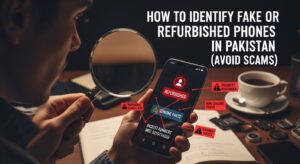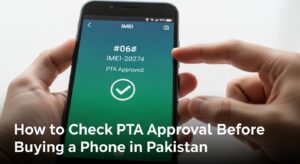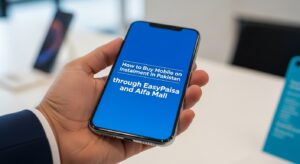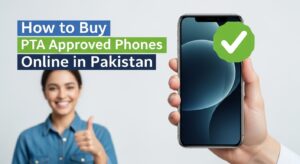Planning to buy a new or used phone in Pakistan? Whether you’re in a busy market like Hall Road in Lahore or searching online, it’s easy to get overwhelmed. A bad purchase can be a huge headache, leaving you with a non-PTA approved device or one with hidden faults. To save yourself from this trouble, you need a proper mobile phone buying checklist. This guide will walk you through every critical step, from verifying the phone’s authenticity to testing its hardware, ensuring you make a smart and safe investment.
Buying a new or used phone in Pakistan is a significant decision. You want to make sure the money you’re spending is worth it. This guide is designed to be your best friend in the market, helping you identify a good deal and avoid common scams. So, let’s get started.
What to Check Before You Buy a Phone?
Before you even think about paying, a thorough inspection is crucial. A simple glance is not enough. You need to be methodical and check everything from the outside in. This section covers the essential physical and digital checks you must perform on any device.
Physical Inspection: The First Impression
The first thing to do is a complete physical examination. You’re looking for any signs of damage or previous repair work. Don’t rush this part, and don’t let the seller pressure you. A good seller will give you time to check the phone properly.
- Body and Screen: Hold the phone in your hand. Check for any dents, deep scratches, or cracks on the body. Pay close attention to the corners. Is the screen cracked or has it been replaced? Run your fingers over the display to feel for any uneven surfaces.
- Buttons and Ports: Press every button—power, volume up, and volume down. Do they feel responsive? Test all ports. Plug in a charger and headphones (if applicable) to ensure they work. Check the SIM and memory card slots to see if they open and close smoothly.
- Water Damage Indicators: Look for any signs of water damage. This is often indicated by a tiny sticker (usually white) that turns red or pink when it gets wet. On many phones, this indicator is inside the SIM tray. This is a vital part of your mobile phone buying checklist.
Testing the Hardware: Functionality is Key
A phone might look perfect on the outside, but its internal components could be faulty. You need to test everything to ensure all parts are in working order.
| Display | Open a plain white background image and a black one. Look for dead pixels (tiny dark spots on a white screen) or screen burn (ghost images on a black screen). Test the touch responsiveness by dragging an app icon across the entire screen. |
| Camera | Open the camera app and take photos and videos with all lenses (front and back). Check the flash. Zoom in and out. Listen for any weird noises. The quality should be crisp and clear. |
| Speakers and Microphone | Play a song or video at full volume. Do the speakers sound clear, or is there any distortion? Make a quick test call to a friend and ask them to confirm if they can hear you clearly and if you can hear them well. |
| Battery | Check the battery health in the settings. For iPhones, go to Settings > Battery > Battery Health. For Androids, look for third-party apps or use built-in diagnostic tools. A battery health of 85% or higher is generally considered good for a used phone. |
Verifying Authenticity: The Most Important Part of Phone Buying Checklist
This is where things get serious, especially in the Pakistani market. A large number of phones are not officially registered, which can lead to your SIM being blocked. This is why a proper PTA approved phone check is not just recommended, it’s absolutely necessary.
The Crucial PTA Approved Phone Check
Pakistan Telecommunication Authority (PTA) has a system called DIRBS (Device Identification, Registration, and Blocking System) to ensure that all mobile devices used in the country are legally imported and tax-paid. A non-compliant phone will eventually be blocked and will not work with any local SIM. Always perform a PTA approved phone check before you hand over any cash.
How to Check PTA Approval Status?
This is a simple but vital step on your mobile phone buying checklist Pakistan. You need the phone’s IMEI number.
- Find the IMEI Number: Dial *#06# on the phone’s keypad. The IMEI number(s) will appear on the screen. If it’s a dual-SIM phone, it will have two IMEI numbers. You should also check if the IMEI on the phone’s box (if available) and the sticker on the back of the phone (if it has a removable battery) match the one displayed on the screen.
- Verify the IMEI: You can verify the IMEI number through three methods:
- SMS: Send the 15-digit IMEI number to 8484. You’ll receive a reply instantly telling you if the device is “Compliant,” “Non-Compliant,” or “Blocked.”
- Website: Visit the official PTA website and use their Device Verification System.
- Mobile App: Download the “DIRBS” app from the app store and enter the IMEI there.
If the device is “Compliant,” you’re good to go. If it’s “Non-Compliant,” it means the taxes have not been paid and the phone will be blocked. A “Blocked” status means the device has been reported stolen or is blacklisted, and you must avoid it at all costs.
Checking for Stolen or Blacklisted Devices
In addition to the PTA approved phone check, you should also be wary of stolen devices. The PTA’s DIRBS system helps with this, as a stolen device is usually blocked. You can also ask for proof of purchase, like the original box and invoice. A legitimate seller will have no problem providing these documents. This is a non-negotiable step.
Why is it so important to get a PTA approved phone? A non-PTA phone will stop working in Pakistan after a certain period. You’ll be unable to use any mobile network services, turning your expensive device into nothing more than a Wi-Fi-only gadget. It’s a risk that’s not worth taking.
Specifics for Buying a Second Hand Phone
Buying a second hand phone is a great way to save money, but it comes with its own set of risks. You must be extra cautious and use an even more detailed second hand phone buying guide to protect your investment. This section is specifically for those looking for a pre-owned device.
What Should I Check on a Used Phone in Pakistan?
Beyond the physical and hardware checks, there are a few more things you need to inspect when buying a used phone. These are often the first things to fail and are difficult to repair cheaply.
- Check for Repairs: Look for any signs that the phone has been opened. Gaps around the screen or body, stripped screws, or a non-original sticker on the back are all red flags.
- Battery Health: As mentioned before, check the battery health. A battery with less than 85% capacity will likely need to be replaced soon, which is an added cost. For Android phones, you can use diagnostic codes to get more info. This is a critical part of any second hand phone buying guide.
- Warranty: Ask the seller if there’s any warranty left, either from the manufacturer or the retailer. This can be a lifesaver if something goes wrong later.
- Seller’s Reputation: If you’re buying from a local shop, ask for the shop’s card and location. If you’re buying from an individual, meet them in a public place and ask for their CNIC copy and proof of purchase. This adds a layer of accountability.
Commonly Asked Questions: People also ask…
Q1: Can I use a non-PTA phone in Pakistan?
No. A non-PTA phone will eventually be blocked from using any local mobile network’s SIM card. You can use it as a Wi-Fi device, but its core function as a mobile phone will be lost. It’s a risk you should avoid at all costs by using our mobile phone buying checklist Pakistan.
Q2: How can I verify the authenticity of a used phone’s accessories?
Always ask for the original box, charger, and headphones. Original accessories often have logos or specific serial numbers. If the charger is an off-brand one, it could damage the phone’s battery in the long run. An original box often has a sticker with the IMEI and serial number that should match the phone’s.
Q3: What if the phone’s IMEI number doesn’t match the box?
This is a major red flag and you should not buy the phone. It could mean the phone is stolen, refurbished, or has a swapped motherboard. Always ensure the IMEI on the box matches the one displayed on the screen when you dial *#06#.
Q4: How do I check for screen burn on an AMOLED display?
Open a full-screen white image and a dark gray one. On the white screen, look for tiny discolored spots (dead pixels). On the gray screen, look for “ghost” images or traces of previous screens (like keyboard outlines or app icons). This is a common issue with older AMOLED phones.
Q5: Is it safe to buy a patched or jailbroken phone?
No, it’s highly risky. Patched phones, especially iPhones, can lose their network connectivity with a software update. Jailbroken phones are more vulnerable to security risks. Stick to official, un-modified devices to save yourself from future problems.
Q6: What is a good battery health percentage for a used phone?
For an iPhone, anything above 85% is generally considered good. For an Android phone, you can use a diagnostic app. However, if the battery drains unusually fast during your testing, it’s a sign to be cautious. The battery is a key component on our checklist.
Q7: Can I return a phone if I find a fault after buying it?
This depends entirely on the seller’s policy. Always ask for a short period (e.g., 24-48 hours) to fully test the device and a receipt. A reputable shop will offer this. Private sellers often offer no such guarantee, which is why your upfront inspection is so important.
Q8: What if I find a small scratch on the phone? Should I still buy it?
Minor cosmetic scratches on a used phone are normal. However, if there are deep dents or cracks on the screen, it could lead to more problems down the line. Use your judgment. If the price reflects the cosmetic damage and the phone works perfectly, it might still be a good deal.
Q9: How do I know if the phone’s storage is legitimate?
Open the Settings menu and check the “About Phone” or “Storage” section to see the total storage capacity. You can also try transferring a large file (e.g., a video) to the phone to ensure it has the advertised storage and that the transfer speed is normal.
Q10: Why is a proper mobile phone buying checklist so important?
In a market with a mix of new, used, refurbished, and non-compliant devices, a checklist saves you from getting scammed. It ensures you verify a device’s authenticity, functionality, and legal status before you spend your hard-earned money. It’s the only way to be confident in your purchase.
Final Thoughts
Buying a phone in Pakistan doesn’t have to be a gamble. By following this comprehensive checklist, you can approach any purchase with confidence. Remember to be patient, thorough, and never feel pressured. A few minutes of careful checking can save you from a major financial loss and a lot of frustration.
Whether it’s a brand-new device from a franchise or a second hand phone from a local shop, your due diligence is the most effective tool you have. From the physical condition to the critical PTA check, every step is important. We hope this guide has equipped you with all the knowledge you need to make a perfect purchase. Best of luck with your new phone!
Resources
Mobile Verification, Pricing & Purchase Resources in Pakistan
- Pakistan Telecommunication Authority (PTA) – Official Website – Access the DIRBS system for IMEI verification and mobile registration.
- PriceOye – Compare prices of mobile phones and electronics from trusted sellers in Pakistan.
- Authorized dealer websites for specific mobile brands:
- Popular tech review websites & YouTube channels for unbiased reviews:
- Easypaisa / JazzCash – Some mobile wallets offer mobile insurance plans in Pakistan.










